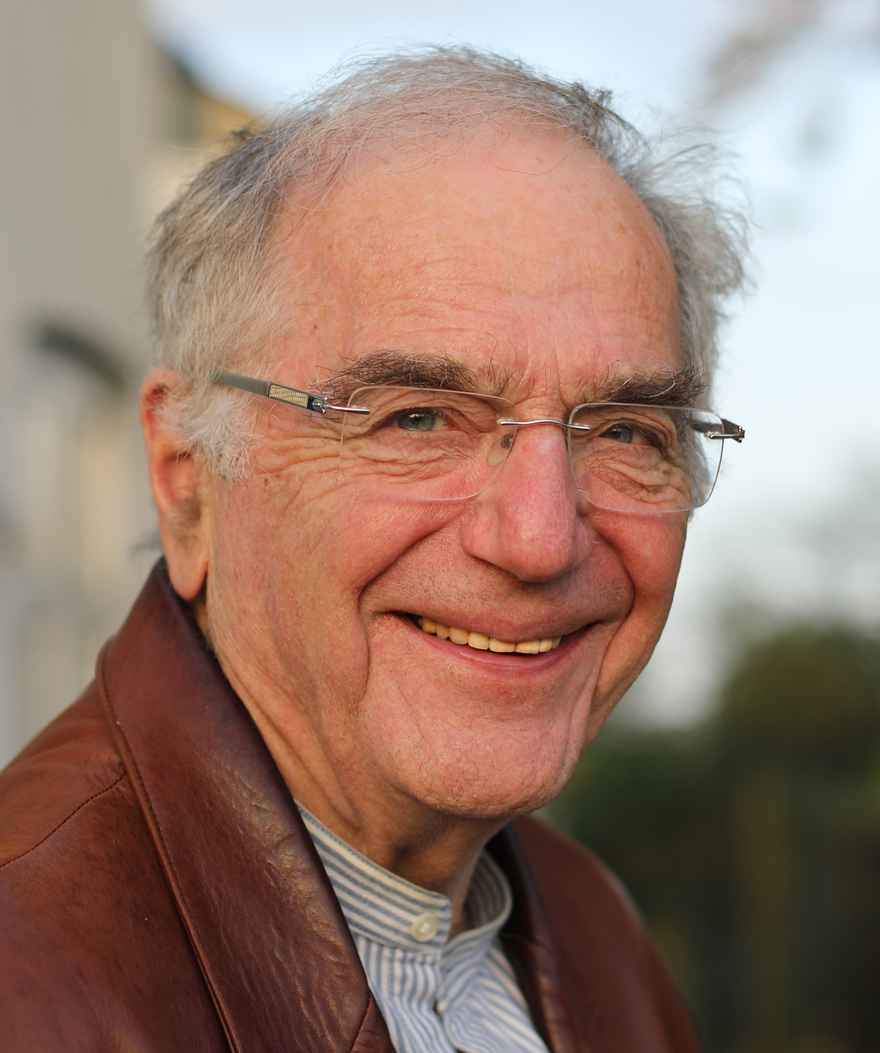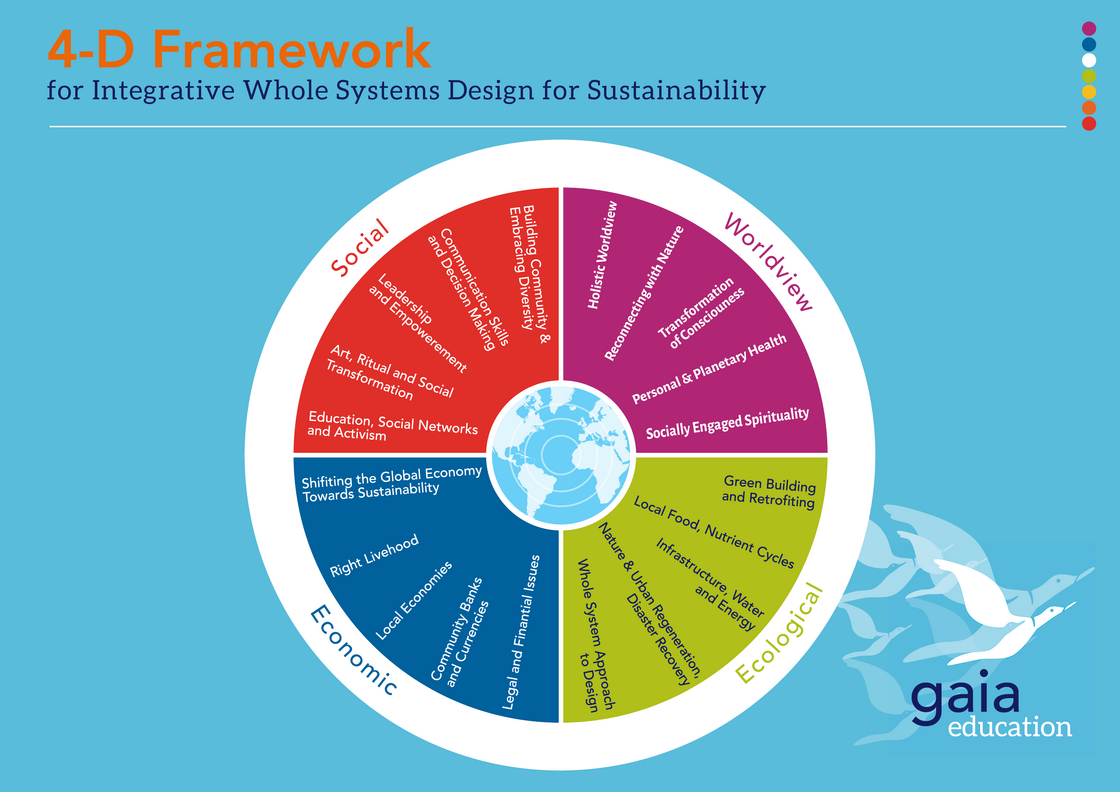The Evolution of Gaia Education

This article was written by Ross Jackson the founder and Chairman of Gaia Education
Gaia Education is an international NGO providing cutting-edge Education for Sustainable and Regenerative Development. In essence, we promote thriving communities within planetary boundaries.
We offer courses, both short and long (a few hours to 8 months), in the holistic design of liveable, sustainable communities, both face-to-face in over 55 countries and online in three languages. In addition, some in-depth specialised courses have been developed together with partners on specific topics. Teaching projects, normally in developing countries, are also carried out regularly in cooperation with aid agencies and local partners. We call this “Project Based Learning”. In recent years, we carried out such projects in India, Bangladesh, Senegal, Zambia and Italy (with refugees and climate immigrants from abroad).
1. THE SOCIAL DIMENSION
The basic content of the teaching is organised around the four dimensions of human living: social, ecological, economic and worldview- the latter including cultural and spiritual perspectives dependent on context. Each dimension consists of 5 modules as described in Gaia Education’s originally designed “sustainability mandala”, which is widely used around the world.

The educational program evolved out of the ecovillage movement in the early 00s. The ecovillage movement in turn can trace its roots back to the emergence of the co-housing
movement in Denmark in the early 1970s.
My wife, Hildur, and I co-founded one of the very first co-housings in Denmark, and lived there for almost twenty years while we brought up our children. The co-housing movement arose as a response to the dilemma of young women who began entering the workplace in great numbers, and faced two equally unattractive choices: focus on their careers with the children in a nursery while missing near contact in the first years; or stay home and bond with the children with the risk of delaying or ruining their careers. Co-housing was seen as a third option.
The basic idea was for each family to have its own private quarters, ideally a stand-alone house, as part of a circle or semi-circle with no fences or hedges between homes, and with a common house for sharing tools, eating together once or twice a week, holding meetings and parties, etc. In the middle was an open space for children to play out of the danger of traffic, as the cars were parked around the periphery. A second motive for the early co-housing projects was the feeling that a sense of community had been lost in the individualistic modern state. We saw co-housing as a step in the right direction to rectify that.
Interestingly, many of these ideas were later adopted by many mainstream architects, who immediately saw the attractiveness of the concept for a certain segment of the population. Many mainstream suburbs in Denmark and elsewhere today illustrate these principles. Actually, most of the co-housings build in Denmark since then- over 200 of them- are for senior citizens. Now, in the 2020s, there is an upsurge of interest from young couples looking for an alternative to city life, both as regards cost and quality of life. The motivations of the people who built the first co-housings were purely social, the first dimension of the Sustainability Mandala.
2. THE ECOLOGICAL DIMENSION
There was only sparse interest in ecology and sustainability throughout most of the 1970s and 1980s, but that all changed with the UN-initiated “Brundtland Report” in 1987. Suddenly the word “sustainability” was on everyone’s lips.
It was also something that Hildur and I talked a lot about, having animals and growing more food. That same year we co-founded Gaia Trust, a Danish charity, with the purpose of supporting the transition to a more sustainable and spiritual world. We felt we should walk our talk, so we left our co-housing near Copenhagen and bought a farm in Western Denmark near the North Sea, where we planned to grow food, build windmills, construct a biological wastewater system, and invite others to join us in an extended version of co-housing with a teaching centre and an ecological dimension.
In September of 1991, we invited a dozen or so like-minded friends from our international network to Denmark to brainstorm with us for several days with the purpose of helping us decide how best to use the Gaia Trust funds. After many long and inspiring discussions, we came to an unexpected conclusion: (1) We know what the problems are. (2) In fact, we know what the solutions are. We do not need more white papers or conferences or think tanks. (3) What we need is implementation.
So, we asked ourselves: who is actually doing something on the ground and not just talking?
Our attention was then drawn to several small intentional communities that were doing just that: the Findhorn Foundation community in Scotland, Auroville in India, Damanhur in Italy, Solheimer in Iceland, Lebensgarten in Germany, The Farm in Tennessee, USA, Crystal Waters in Australia. We were told there were many others. So, we began to develop a vision. What if we were able to map these projects and link them together in a global network, where they could exchange best practices and experiences. We coined the word “ecovillage”, which did not exist at the time, to describe these projects.
We could promote lifestyle change in sustainable, intentional communities as a strategy for combating climate change. If we were successful, they would inspire replication and possibly grow into a global ecovillage movement that could be a game-changer. We imagined what might happen after a collapse, as foreseen in the Limits to Growth model. Perhaps ecovillages could form the foundation for rebuilding something new. Thus was born the ecovillage movement and the ecological dimension of the Gaia Education Sustainability Mandala.
3. THE FOUNDING OF THE GLOBAL ECOVILLAGE NETWORK (GEN)
Over the next four years, the concept was refined. A core group met in several different ecovillages to plan next steps. We decided that the first step should be linking existing ecovillages into regional networks. We would set up one in the USA with headquarters at The Farm in Tennessee for the Americas with Albert Bates; one in Lebensgarten, Germany for Europe and Africa with Declan Kennedy; one for Asia and Oceania at Crystal Waters in Australia with Max Lindegger; and an international coordinating office in Denmark with Hamish Stewart. We presented the strategy and our intention to immediately found the Global Ecovillage Network to an enthusiastic audience at the Findhorn Foundation conference on Sustainable Communities in October 1995. Gaia Trust agreed to fund the project for the first five years.
The first public event with GEN was at the UN Habitat 2 conference in Istanbul in June of 1996. Twenty GEN folks from around the world offered over 40 workshops and had the biggest NGO exhibition with a straw bale wall full of ecovillage photos, a windmill, a dart game, a big map where visitors could put a pin on their home location, music, snacks, a water mill with running water circulating, and the biggest attraction of all: circle dancing every day at 3 p.m. with Declan Kennedy, the first GEN chairman, who was a professional dancer in his youth. Folks from the official conference came by every day and were so impressed that they invited GEN to address the main conference with its vision. The message included a proposal for the UN to allocate $100 million to build 50 ecovillages across the planet in different habitats. They responded that they had no money. Big letdown, but that did not stop GEN from growing.
4. GAIA EDUCATION IS BORN
Part of the original vision was to develop cross-regional activities once the networks were established. By 1998, the networks were developing nicely and we were ready to do just that with an obvious choice—education. Hildur and I invited a select group of 50 educators from the GEN network to come to Denmark and brainstorm around the topic: education for sustainability. By the end of the week, we had developed the Sustainability Mandala and assigned tasks to the thirty or so persons, who wished to carry on and develop the 20 modules. Over the next 6 years, the group met in a number of different places, listening to each other teach, and critiquing the presentations. Our final meeting was in Hungary, where we expressed satisfaction with the result and elected a board with May East as CEO. Gaia Education was launched formally at the “GEN plus 10” Findhorn conference in October 2005. “Next GEN” for GEN youth was launched at the same time. One of the issues was whether Gaia Education should be the educational division of GEN or an independent sister organisation. We chose the latter for various reasons. Gaia Education Limited was founded as a Scottish Charity with trustees as shareholders and board members. GEN was different—a network organisation.
5. THE WORLDVIEW DIMENSION
I visited a lot of ecovillages around the world in the 1990s and 00s, both with GEN and with Gaia Education. The thing that made the greatest impression on me was the sense of belonging to one big, international family. No matter where we went, we had the same values, in spite of differences in race, religion, culture or language. The common mantra seemed to be “Care of the Earth, Care of Each Other”, the diametrical opposite of the dominant worldview of the mainstream. It was a profound realisation for all of us that, deep down, we are all the same. For me, this experience emphasised the importance of teaching our course participants to understand other cultures, customs and religions and appreciate them as reflections of the same impulse, just in different packaging. This was the background for us introducing Worldview as an important dimension in holistic thinking. A number of people have remarked since that this was a valuable extension of the traditional UN assignment of just three divisions: social, ecological and economic. Worldview was Gaia Education’s signature dimension. The UN itself has been remarkably enthusiastic about Gaia Education’s approach, with
UNESCO including us as partners in their Global Action Programme for Education for Sustainable Development (ESD) and UNITAR increasingly partnering with us and endorsing our online courses and Sustainable Development Goals training programmes. Through this, Gaia Education is evolving as a bridging institution between global SDG and ESD policy and grassroots action by communities on the ground.
As a vital step in converting rhetoric into action, we have been increasingly partnering with leaders in the field of Worldview transformation, such as Jeremy Lent and Fritjof Capra, to
run courses which challenge people’s current paradigm and bring them into greater connection with themselves, each other and the natural world.
6. THE ECONOMICS DIMENSION
Our teaching of economics has two very different perspectives—micro and macro. The micro perspective is about all the nitty gritty you have to know to start up an ecovillage project—making a budget, using a spreadsheet, negotiating with farmers and municipalities about purchasing land, building techniques, how houses are financed, and an insight into banking and the way they evaluate risk. This part would also include concepts like local currencies as a way to kickstart activity without borrowing from the bank. The macro side was about how the global economy and national economies work, including their sometimes-weird assumptions, and about explaining why we were in such a dysfunctional world with life-threatening climate change hanging over us, while eight individuals have more wealth than half the world population combined. But it was also about local economies, what I would today call regional development, namely, looking at ways to invigorate regions in the coming age of decentralisation.
We can expect to see solar panels on every roof and preferences for local food that will together will drive a rural renaissance. Increasingly, our partners in Global South countries working tirelessly, using Ecovillage Design principles, to support communities facing climate change crises so that they can salvage their settlements and livelihoods, have asked for Gaia Education’s support. In response, we launched our project-based learning programmes (PBLs), funded largely by DFID and the Scottish Government, in order to extend our EDE training into long-term support for these communities. As examples:
In Bangladesh, with Bangladesh Association for Sustainable Development, we supported 2000 villagers (75% female) in coastal communities facing floods, typhoons and soil salination to adapt their homesteads, adopt regenerative agriculture techniques, transform salinised soil into rich, productive land and, increase household income by 23% In Senegal, with REDES, in a project given an ‘A’ grade by DFID, we supported 1866 farmers (80% female) in the Podor region, facing desertification due to agro-industrial farming techniques and climate change, to restore their land into flourishing, abundant fields using agro-ecological techniques. Their food production increased by 93%. In Zambia in 2018-22, working with WWF Zambia and the Young Emerging Farmers Initiative, we supported 500 young farmers to lead multimedia conservation campaigns reaching 500,000 youth, and leading 2100 households to adopt more sustainable agricultural, livelihood and natural resource management practices. They increased participating households’ income by 40% as well as their food and nutrition security, principally via beekeeping. They also saved 3500 hectares from being deforested by charcoal production and produced high-quality honey which they are now attempting to export.
Our PBLs have proven that our trainings work in climate crisis situations. In fact, they are transformational, and we would love to do many more. However, funding for such project is hard to come by, even though we believe it to be the most vital work in the world at this stage of climate change.
7. LOOKING FORWARD
In the 2020’s we can expect to see Gaia Education increase its bridging role between international SDG policy work and cutting-edge, localised, community-led action on the ground. We are developing a larger range of short, intermediate and in-depth online courses covering all four dimensions of our mandala. For many of these, we will partner with individuals and organisations leading in the field of regeneration across the globe, as well as UNITAR and other academic institutions. In the context of global weather changes, floods and fires we see across the world, we are, in particular, planning courses to support communities to “design for resilience” in times of emergency.
We will be working more closely with our sister organisation, GEN, in building our networks, in fundraising, in developing PBLs and in coordinating our respective educational activities, in particular our face-to-face Ecovillage Design Education and Training of Trainers courses. And we will continue working with UNESCO, promoting SDG awareness via our SDG Multiplier workshops and cards and lobbying for the implementation of policies under SDG 4.7.
We will strengthen and support all of our international networks as they spread the word on Ecovillage Design Education. We will create a digital platform to support the cross-pollination of our growing Community of Practice, with a strong focus on supporting our youth networks to build towards a resilient future. We will continue to work, in particular, with our European partners to develop new ESD teacher guides, formal and informal ESD curricula, tools for transitioning to regenerative lifestyles and platforms for accessing all of our products for free. With the creation of our partner organisation, Gaia Education Europe, based in Brussels, we hope that Erasmus+ will continue to support these endeavours. We expect to see an increased presence in Africa, where we are building partnerships with
key educational pan-African institutes such as the SDG Center for Africa. Together, we have developed a proposal with the Association of African Universities and the All Africa Students’ Union to provide all African university students with short courses to increase their understanding of the African perspective on the SDG and Climate Change crises, as well as signposting them to localised action on the ground. And we will promote holistic principles and design as an integral part of Education for Sustainability in formal and informal settings across the continent.
We believe that Gaia Education will go from strength to strength, as the World awakens to the huge dangers of climate change and our unsustainable human presence. We are ready, with tried and tested, cutting-edge, holistic approaches to creating community changemakers who can overcome the vast social, economic, ecological and cultural challenges we face. We live in daunting times, but we feel up to the task, and the receipt of awards such as the Luxembourg Peace Prize for Outstanding Peace Education galvanise us on our journey.


0 comments
Leave a comment